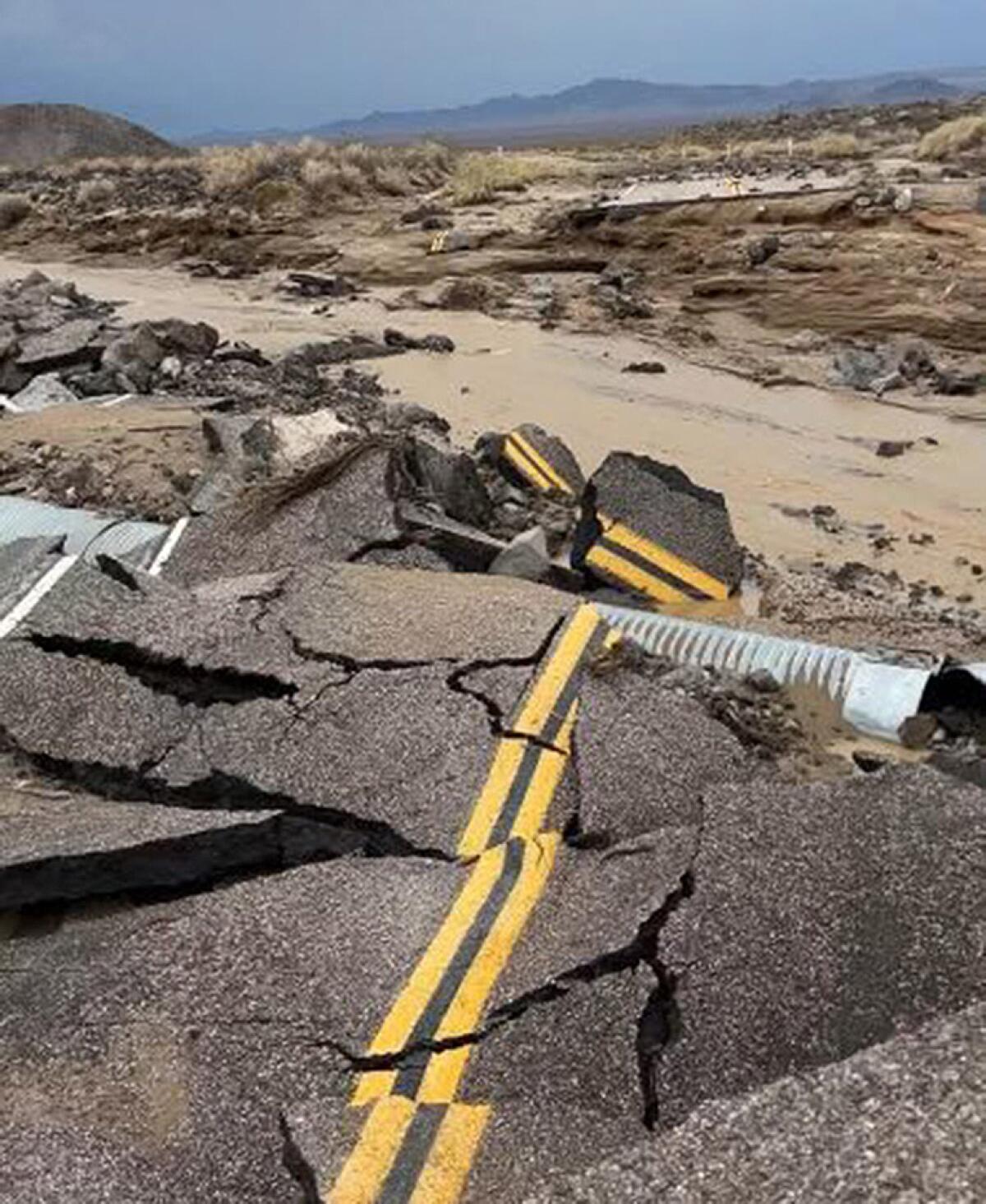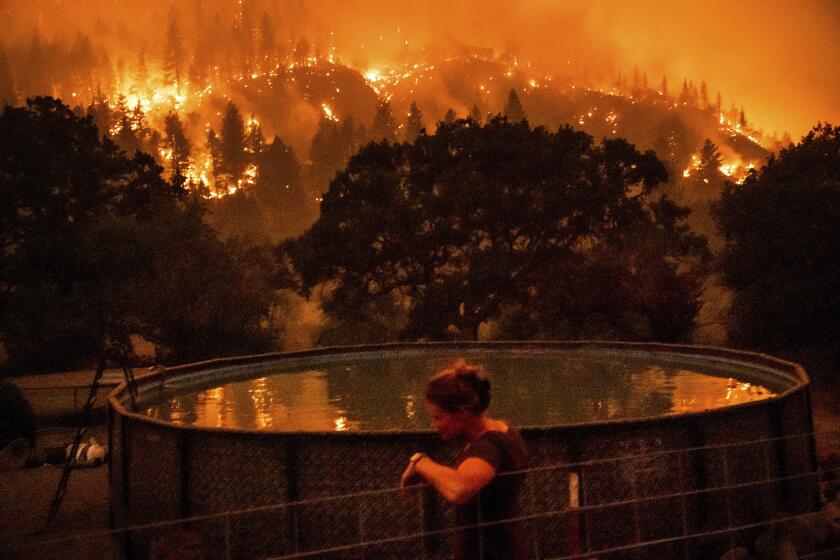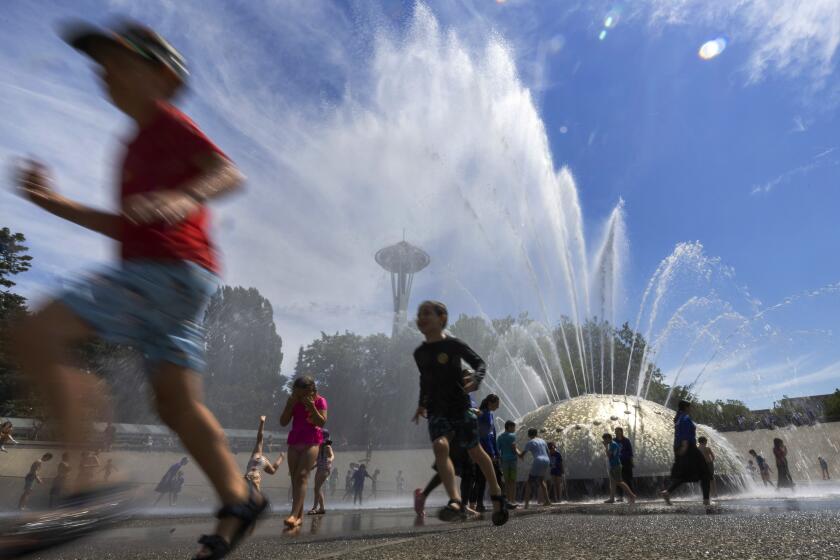Mudslides, rainfall, trapped motorists as intense monsoonal storm hits California

- Share via
August is off to a sticky, wet start as a monsoon flow dogs California.
Some parts of the state saw heavy rainfall over the last few days, while others endured flash floods and debris flows. Other areas saw little of either, but endured a hot, sticky mess of high humidity, which is expected to break off over the next few days but will stubbornly return by the weekend, according to the National Weather Service.
Approximately 30 drivers were stranded in their cars Sunday as heavy rain sent mud and debris onto Highway 38 leading to Big Bear. The Angelus Oaks area in San Bernardino saw a little more than an inch of rain, according to the National Weather Service, which was just enough to send mud flowing down from the 2020 burn scar left by the El Dorado fire.
Due to the possibility for more thunderstorms on Monday, a 12-hour flash flood watch began at 10 a.m. for the San Bernardino and Riverside mountains.
Farther north, Death Valley National Park was closed after fast-moving flood waters buckled and damaged the roadways. Flash floods also hit the Mojave National Preserve and major roadways leading to the preserve are closed due to damage from the water, according to CalTrans.
“It’s monsoon season for SoCal,” said Casey Oswant, a meteorologist with the National Weather Service in San Diego. “We’re getting a lot of moisture being pulled up from the Gulf of California.”
The McKinney fire has ripped through 52,498 acres in Klamath National Forest. A red flag warning is in effect, and storms are expected.
Simply put, a monsoon is a shift in the wind pattern. Monsoon flows pull moisture up into Arizona, California and Nevada after a shift in the pattern near the upper troposphere and can sometimes last a few days or stretch over longer periods of time, according to meteorologists. This means more moisture lingering in the air with the higher temperatures.
On Monday, temperatures will reach the upper 70s and 80s from the beaches to downtown Los Angeles, according to forecasts. In the San Gabriel Valley, the highs will be around 90.
Overnight lows did not help cool things in Los Angeles County on Sunday, meteorologist David Sweet with the Oxnard office said. The overnight low in Burbank reached 72 degrees, which was one degree warmer than the record set in 2020, while Los Angeles International Airport and Santa Barbara Airport saw temperatures tie their records set in 2015.
Monsoonal showers and thunderstorms could pass over the mountains in Los Angeles and Ventura counties, along with the Antelope Valley, according to forecasts.
In the San Francisco Bay Area, meteorologists are watching for thunder as storms travel east from the coast.
Meteorologist Sarah McCorkle with the National Weather Service in Monterey said downtown San Francisco saw one of its wettest Julys in recent years. But last month the city did not break a record set in 2015, which saw 0.07 inches of rainfall versus 0.04 inches this year.
“It’s not a lot of rainfall,” McCorkle said, “but it’s worth noting for the month of July, which is typically the driest month of the year.”
The two cities set records for most consecutive days of high temperatures amid a heat wave that officials suspect precipitated a number of deaths.
High pressure is passing over southwestern areas of the United States, causing extra moisture. Just outside California, the dewpoint — which measures water vapor in the air — has been persistently high, according to meteorologist Ashley Nickerson with the National Weather Service in Las Vegas.
On Monday, just northwest of Las Vegas, Lee Canyon Highway received over 2 inches of rain over a one-hour period. A flash flood warning was called into effect shortly before noon.
More to Read
Sign up for Essential California
The most important California stories and recommendations in your inbox every morning.
You may occasionally receive promotional content from the Los Angeles Times.













